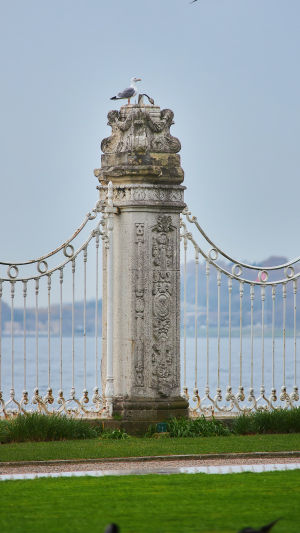The Dolmabahçe Palace in Istanbul stands as a grand testament to the evolving identity of the Ottoman Empire during its transformative journey from a sultanate to a republic in the 19th century.
Now 166 years old, this architectural marvel came into existence during the reign of Sultan Abdul Mejid, driven by the realization that the existing Besiktas coastal palace lacked functionality.
Plans for the construction of Dolmabahçe Palace were meticulously drawn up on June 13, 1843, and subsequently set into motion.
The construction of this iconic palace involved the expertise of renowned architects of the time, including Abdülhalim Bey, Altunizade İsmail Zühtü Pasha, Karabet Balyan, Ohannes Serveryan, Nikoğos Balyan, and James William.
Situated along the waterfront, the palace officially opened its doors on June 7, 1856, spanning an impressive 110,000 square meters and offering breathtaking views. Post-completion, the bay, once a haven for ancient ships, became a favored locale for the Sultanate.
The relocation of the Ottoman rulers' residence from Topkapır Palace to Dolmabahçe Palace marked a pivotal shift in the political and social landscape of the Ottoman Empire. Dolmabahçe's architectural integration of Western styles reflected a changing societal mentality and spirituality.
Dolmabahçe Palace housed notable rulers such as Sultan Abdulaziz, Sultan Abdulhamid, Sultan Murad V, Sultan Reşat, Sultan Wahidin, Khalifa Abdulmahid, and Mustafa Kemal Atatürk, the Founding Father of the Turkish Republic, post the Republic's declaration.
The palace's structural layout encompasses three distinct sections: the administrative office, overseeing state affairs; the harem, a private domain for the Sultan and his family; and the ceremonial hall (Muayede Salonu), reserved for significant state ceremonies.
Dolmabahçe Palace distinguishes itself from Topkapi Palace through its use of Rococo, Baroque, and Neoclassical architectural styles. Unlike the expansion-based design of Topkapi Palace, Dolmabahçe Palace follows a predetermined layout.
A captivating aspect of the palace lies in its incorporation of cutting-edge technology of the time. Central heating, electricity, and telephones were among the luxurious amenities installed. The palace boasts a total living area of 45,000 square meters, featuring 2 rooms, 285 halls, 46 hammams, 6 toilets, and 68 square meters of precious carpets.
The Mabein area, the Sultan's daytime workspace, stood out as the most functional and opulent section.
The Medhal Hall, serving as the entrance, led to a crystal staircase, the Ambassadors' Hall for diplomatic engagements, and the Red Room for receiving diplomats. Upstairs, the Zulvecheyn Hall guided visitors to the Sultan's private suite in the men's section, complete with a resplendent hammam, brought from Egypt, a study, and a hall.
Dolmabahçe Palace encapsulates not only the historical transition of the Ottoman Empire but also the synthesis of cultural influences, architectural brilliance, and technological advancements of its time. This enduring symbol of the past continues to captivate visitors with its rich tapestry of history and opulence.
Dolmabahçe Palace, beyond its historical significance, unfolds a narrative of opulence and innovation. The palace, sprawling across 110,000 square meters, presents a synthesis of Rococo, Baroque, and Neoclassical architectural styles, setting it apart from its predecessor, Topkapi Palace.
The meticulous planning and predetermined layout showcase a departure from the expansion-based design of the era.
Remarkably, Dolmabahçe Palace not only mirrored Western architectural trends but also embraced cutting-edge technology. The incorporation of central heating, electricity, and telephones marked a futuristic approach, highlighting the palace as a beacon of modernity in the 19th century.
The opulent interior, adorned with 68 square meters of precious carpets, 285 halls, and 46 hammams, symbolizes the grandeur of the Ottoman Empire during its transition.





